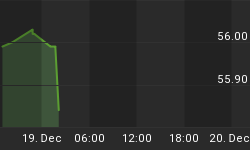Perhaps the biggest wild card in the 2005-2006 timeframe for silver prices is the introduction of the silver ETF and its success (or lack thereof). Since early last year, silver bulls such as ourselves have been taken with the notion of a silver ETF and its impact on the silver market. Silver is such a small, tight, relatively illiquid market that a successful innovation in the way for individuals and mutual funds to own silver (without the hassles of storage costs and steep premiums to spot) could have a pronounced effect on the silver price.
The gold ETF was launched late last year after a very long and frustrating battle with the SEC to get the ETF registered and approved for trading. The belief last year was that the powers that be in the silver industry would follow the blueprint the World Gold Council laid out in its ETF and that the silver ETF would have much smoother and quicker sailing. So far the jury is out on smoother, but quicker does not appear to be the case as a proposed silver ETF has not even been filed with the SEC. Our sources have long indicated that an oil ETF would be the next commodity ETF to get done, then silver, copper, and a few others would likely follow. So it was with great interest that these two headlines passed our desks recently:
05-18-05 07:18 PM EST
NEW YORK -(Dow Jones)- Standard Asset Management, a company created by Ameristock Funds, filed a registration statement with the Securities and Exchange Commission to create an exchange-traded fund that tracks the price of oil.06-08-05 07:25 AM EST
LONDON -(Dow Jones)- Barclays Global Investors, a unit of U.K.-based Barclays PLC (BARC.LN), will file an application for the first silver exchange traded fund with the U.S. Securities and Exchange Commission before the end of the year, a spokeswoman told Dow Jones Newswires Wednesday.
So some progress is being made. An oil ETF was actually filed with the SEC. And it appears that Barclays is getting close to filing a registration statement with the SEC for a silver ETF. A silver ETF trading in 2005 now appears to be a long shot with 2006 being the more likely timeframe. However, the ETF is closer to becoming a reality and its impact on silver is likely to be far more pronounced than gold or oil. How big an impact is anyone's guess.
The two U.S. gold ETFs (tickers: GLD & IAU) have combined to gather a little around 6 million ounces or about $2.6 billion in assets since November. These ETFs have seen their assets steadily increase month after month for the first 6 months despite a generally lower gold price. If silver could muster annually just 1/10th of what gold did in only 6 months, we are talking about $260 million in silver ETF demand, which at a $7.20 silver price implies 36 million ounces in incremental demand for silver. We will argue the effect will likely be much more over time, but 36 million ounces seems a conservative starting point. Below, we have hazarded a guess based on annual gold demand versus gold U.S. ETFs size and what their relationship in gold might mean in silver. We then applied that to silver and tried to again come up with a conservative estimate of the ounces a silver ETF may suck up. The shaded cells are the estimates derived from our analysis. One can see how a 46.4 million ounce estimate is finally arrived at:

Likewise, we are emboldened on the silver ETF's chances for success in light of the huge investment demand increase (34 million ounces) silver exhibited in 2004 and the reports of continued demand in 2005. In fact, early 2005 results for gold show increased demand in 2005, which should bode well for silver. To quote from the World Gold Council Q1 report (silver demand statistics are only available annually):
"The first quarter of 2005 saw exceptionally strong demand for gold, particularly from the jewelry sector, from bar and coin purchases and from investment in gold backed exchange traded funds (ETFs). End-user consumption (which includes all identifiable categories of demand) was 26% higher in tonnage terms and 32% higher in dollar terms, compared to the same period in 2004."
The stage seems set for a successful silver ETF as investment demand for the metal is increasing thanks to the Dollar and other fiat currencies' weaknesses, along with tightening inventories.
more follows for subscribers . . .
















